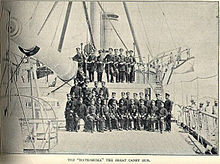Artillery of Japan

Artillery in Japan is recorded in the 13th century. It was not used widely before the Sengoku period in the 16th century.[1]

History
[change | change source]In the 1840s, the Tokugawa Shogunate began to anticipate that either British or French military might attack Japan. Takashima Shuhan (1798-1866) submitted a petition to the shogun calling for the purchase of Western firearms. In 1841, a demonstration of Western gunnery made a strong impression.[2] Powerful conservative factions in the shogunate resisted change.[3]

During the 1864 Bombardment of Shimonoseki, European naval guns were shown to be superior to Japanese cannon on shore.[4]
Following the Meiji Restoration, Japan would pursue a policy of "Rich country, strong army" (富国強兵), which led to a general rearmament.
Imperial Japanese Army
[change | change source]The Imperial Japanese Army (IJA) used artillery during the First Sino-Japanese War (1894–1895).
Naval guns and field artillery were important in the Russo-Japanese War of 1905.
Before and during World War II, the Japanese Army deployed a variety of artillery pieces.
Imperial Japanese Navy
[change | change source]
The Imperial Japanese Navy (IJN) developed large naval artillery pieces.
Japan Self Defense Force (JSDF)
[change | change source]The self-propelled artillery of the current Japanese military include
- Type 75 155 mm self-propelled howitzer
- M110 howitzer
- M270 MLRS
- Type 99 155 mm self-propelled howitzer
Related pages
[change | change source]References
[change | change source]- ↑ Perrin, Noel. (1979). Giving up the Gun, Japan's Reversion to the Sword, 1543-1879, p. 93.
- ↑ National Diet Library, "Acceptance of Western Military Science at the End of Edo Period, Land Wrfare Tactics"; retrieved 2012-2-22.
- ↑ Akamatsu, Paul. (2001). Meiji 1868: Revolution and Counter-revolution in Japan, PP. 50-51.
- ↑ Perrin, p. 76.
Further reading
[change | change source]- Evans, David C and Mark Peattie. (1997). Kaigun: strategy, tactics, and technology in the Imperial Japanese Navy, 1887–1941 Naval Institute Press, Annapolis, Maryland ISBN 0-87021-192-7
Other websites
[change | change source]
